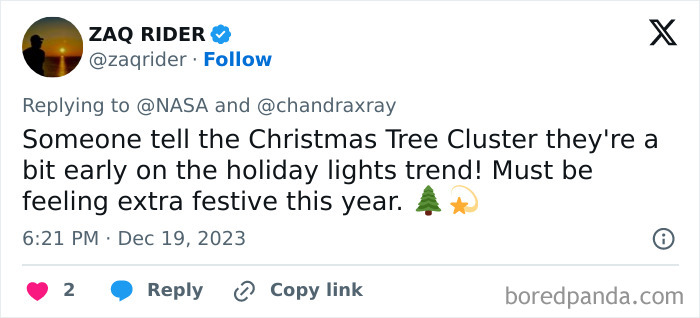On the first day of Christmas, NASA gave to me, a star cluster like a Christmas tree.
The Christmas spirit is everywhere, even out in space, as proven by the US National Aeronautics and Space Administration (NASA), which just released a composite image of a cluster of young stars looking exactly like a cosmic Christmas tree.
On Tuesday (December 19), NASA published an image of a star cluster, known as NGC 2264, which has since been named the “Christmas Tree Cluster”.
It shows the shape of a cosmic tree with the glow of stellar lights, and is composed of many young stars, with ages between about one and five million years old, the administration explained.
NASA published an image of a star cluster, known as NGC 2264, which has since been named the “Christmas Tree Cluster”
Image credits: NASA
Image credits: NASA
All of these little stars are in our Milky Way, located about 2,500 light-years away from Earth, and are both smaller and larger than the Sun, ranging from some with less than a tenth the mass of the Sun to others containing about seven solar masses, NASA stated.
In the jolly photograph, the cluster’s resemblance to a Christmas tree has been enhanced through image rotation and color choices.
According to the American Space Administration, optical data from a telescope showed gas in the nebula represented by wispy green lines and shapes, which created the boughs and needles of the tree shape.
Iconic astronaut Dr. Buzz Aldrin took to his X account (formerly known as Twitter) to react
Image credits: TheRealBuzz
Image credits: LMSpace
Moreover, X-rays detected by NASA’s Chandra X-ray Observatory, a powerful telescope, were presented as blue and white lights and resembled glowing dots of light on the tree.
Additionally, infrared data showed foreground and background stars as gleaming specks of white against the blackness of space, NASA noted.
The administration noted that the image was rotated by about 150 degrees from the astronomer’s standard of North pointing upwards, putting the peak of the roughly conical tree shape near the top of the image.
The cluster’s little stars are in our Milky Way, located about 2,500 light-years away from Earth, and are both smaller and larger than the Sun
Image credits: AlfredAnywhere
Image credits: Mortezabihzadeh
The result was so impressive and convenient, making an appearance just in time for the holidays, that even iconic astronaut Dr. Buzz Aldrin took to his X account (formerly known as Twitter) to react.
He wrote: “This certainly gets me into the holiday spirit – a new picture of the “Christmas Tree Cluster,” which is technically NGC 2264, a cluster of young stars. I hope you’re all enjoying this festive season and looking forward to Christmas!”
The discovery of the festive cluster of young stars comes a month after NASA revealed a new view of the universe via a galaxy cluster with assistance from both the James Webb Space Telescope and the Hubble Space Telescope, CBS News previously reported.
Optical data from a telescope showed gas in the nebula represented by wispy green lines and shapes
Image credits: Stu5Kart
Image credits: SunWeatherMan
Officially named MACS0416, the cluster is located approximately 4.3 billion light-years from Earth, according to the space agency.
MACS0416 has been dubbed the “Christmas Tree Galaxy Cluster” because “it’s so colorful and because of these flickering lights we find within it. We can see transients everywhere,” Haojing Yan of the University of Missouri in Columbia said, as per People.
Many space enthusiasts reacted in amazement
Image credits: chewybass1
Image credits: NIglobal
Image credits: theskymoneyboss
Image credits: zaqrider
Image credits: AshlayJoe
Image credits: OneMonarchTwo
Image credits: Snshores
Image credits: ifkate
Image credits: SrSergioG
Image credits: ybg_bwinjo
Image credits: BodybyFelix
Image credits: zaqrider
Image credits: yourfriendleroy

Dr. Thomas Hughes is a UK-based scientist and science communicator who makes complex topics accessible to readers. His articles explore breakthroughs in various scientific disciplines, from space exploration to cutting-edge research.




























